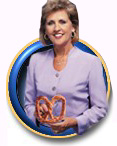“The problem is not that there are problems. The problem is expecting otherwise and thinking that having problems is a problem.” -Theodore Rubin
Her Challenges:
- She was the baker and bread maker for her seven siblings and parents.
- Only had a ninth grade education.
- Learned how to make pretzels at a food stand at a farmer’s market the Pennsylvania Dutch way. Before that she worked as a waitress and she learned about costumer service.
- Had a market stand in Maryland in 1987 where she handmade pretzels.
- Rented a stand in Pennsylvania in 1988, calling it Auntie Anne’s Pretzels.
- Had to redo the recipe for the pretzels because they were dissatisfactory.
- After a year, she had eight stand alone stores and her first store in a mall.
- Only advertisement was the costumers talking about how good her pretzels were.
- The franchise spread throughout Central Pennsylvania in 1989.
- Her daughter, Angela, died from an accident when she was 19 months old.
Who is Anne Beiler?
Some Highlights:
- In May 2005, she received an honorary doctorate from Elizabethtown College and a doctorate from Eastern University.
- She wrote the books Auntie Anne: My Story with illustrations by artist Frieman Stoltzfus and Twist of Faith: The Story of Anne Beiler, Founder of Auntie Anne's Pretzels.
- Delivered a speech at the 2008 Republican National Convention in September 2008.
- Provides fundraising ideas for schools and non-profit, community groups.
- Auntie Anne’s Pretzels received the Best in Food Category Award in 2009 and the Franchise Satisfaction Award in 2010.
- Has received the World-Class Franchise honor for the past five years.
How can you solve problems like Anne Beiler?
- Approach the problem with a structured process by asking the following questions:
- Why does the problem exist?
- What is the real problem?
- How did it happen?
- Where and when did it occur?
- Who is involved in it?
- What are the different ways we could approach this situation?
- Develop a list of 5 solutions based on structuring the problem as a question.
- Another option is to use the 20 Question Grid below:
|
|
What? |
Where? |
When? |
Who? |
How? |
|
Current State |
What happened? |
Where is the confusion? |
When is it done? |
Who does the work? |
How are the activities sequenced? |
|
Future State |
What should it look like? |
Where will the process change? |
When will it change? |
Who will do the work? |
How will the activities be timed and resourced? |
|
Gap |
What is different? |
Where will the change make a difference? |
When are the differences considered? |
Who will identify and validate the gap? |
How will the gap be improved and managed? |
|
Is there a better way? |
What alternative solutions are available? |
Where would the alternative solutions be considered? |
When is there a better window of opportunity? |
Who makes the decisions on alternative solutions? |
How will the alternative solutions be viewed by the organization? |
What methodologies do you use to solve problems in your professional or personal life?
References:
http://en.wikipedia.org/wiki/Anne_F._Beiler
http://www.auntieannes.com/AboutUs/AwardsAndRecognition.aspx
Principles of Execution Key Concepts:
- Anne Beiler
- Auntie Anne's Pretzels
- Problem Solving
Share your ideas or thoughts!


